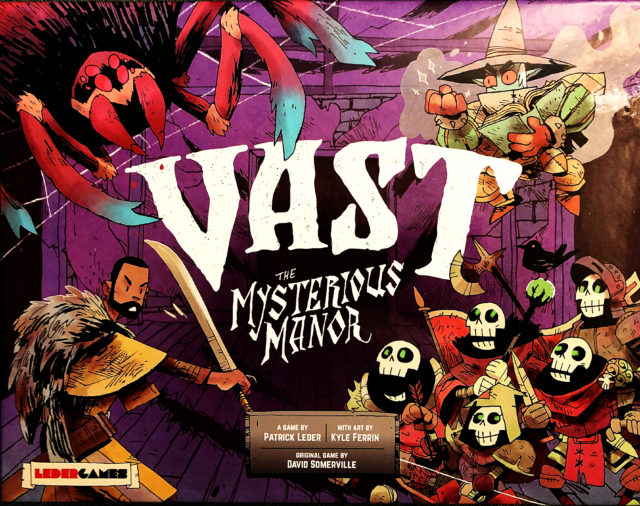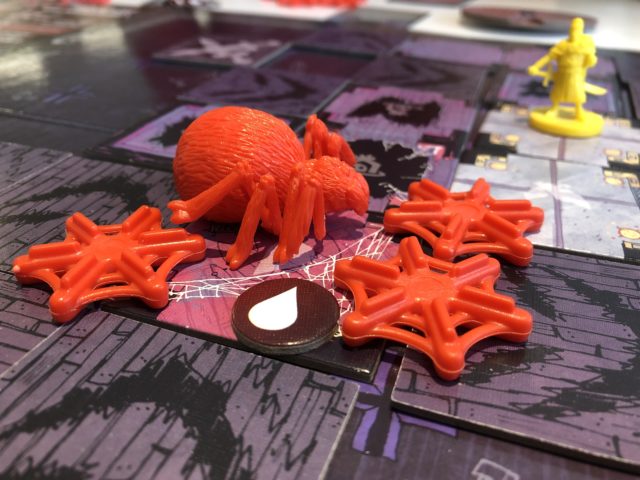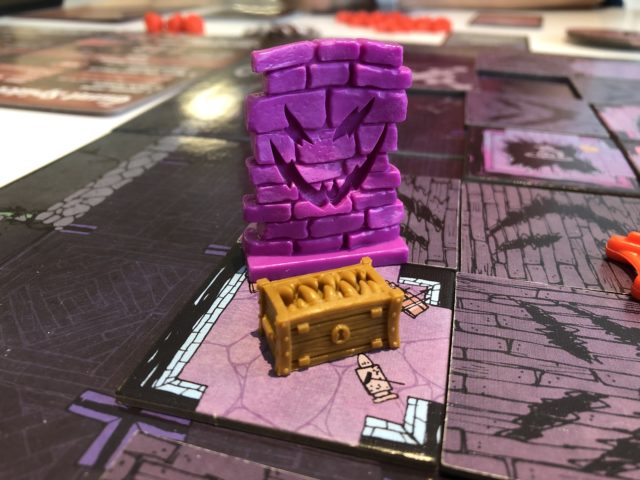Symmetry, in a Tabletop context, is a quality measuring the similarity of each player’s decision-space. I can’t think of any game that is perfectly symmetric, because even something as simple as turn order makes a difference–which is why players take turns going first in Go and Chess tournaments and you never willingly sit to Duncan’s left in Puerto Rico. If a designer thinks this is enough of an issue, she usually nerfs the start player or buffs players lower down in turn order and leaves it at that.

Nonetheless, traditional Tabletop design takes near-perfect symmetry as a given. Players start with identical (or near-identical) resources, do the same things on their turns, and are trying to win according to a common metric, whether by points, eliminating other players’ pieces, reaching the goal first, or what have you.
The virtues of designing games along these lines are pretty obvious. They’re easier to balance, learn and play. Players can monitor each other’s progress and rule-following more easily because everyone is following the same procedures. It’s also easier to compare performance across separate plays of the game. Most gateway games are pretty symmetric for this reason.
The trouble with symmetry, for some anyway, is that it’s too…symmetric. Too flat. Too blah. The more symmetric a game is, the more abstract it’s likely to be, which means there’s no theme or narrative driving play, and in general tend towards predictable or scripted play more easily because players can math out entire sequences of turns. There are exceptions–Siege of Paris is an asymmetric abstract that takes its theme from the climax of the then-current Franco-Prussian War of 1870!
These days I enjoy more asymmetric games. I like unique player powers and decks, unequal (not just random) starting resources, overlapping but separate paths to victory. They’re just more interesting to me, even if they’re more unstable in the sense that you need all players to be roughly equal in ability to keep play in balance. That’s why I liked 2016’s Vast: The Crystal Caverns (Leder Games) so much. It was a truly unique take on the delving experience, definitely not an RPG but with plenty of elements which recalled a stereotypical fantasy dungeonquest.
And Vast: The Crystal Caverns was extremely, I might say violently, asymmetric. Aside from a couple of pages of common rules about movement, exploration, and combat, each of the five possible roles had two pages of completely separate rules. The Knight, Goblin, Dragon, Thief, and Cave (!) did different things on their turns, in different ways, with different components, and had interlocking but different victory conditions. The Knight wants to slay the Dragon; the Goblin wants to kill the Knight; the Dragon wants to come fully awake and escape the cave, the Thief just wants to steal enough Treasure, and the Cave wants to grow to maximum size and then collapse until five Cave Crystals are destroyed.

The result was, to me, a fascinating concoction. Each role required and rewarded a different play style. At higher player counts, there would be a constant making and breaking of alliances, but even with only three playing Knight, Goblin, and Dragon you always had to be aware of how close each player was to victory.
The problem was, it was a beast to bring to the table, let alone to teach to players who hadn’t played before. The teach could take longer than the game, and with so many different and fiddly rules the gameplay lurched along like a student driver learning to drive standard. The general feeling in my play group was, “Mmmm, no. Too much work”; the game wasn’t heavy in conventional terms, but it asked a lot from players for the experience it provided. I disagreed, but it meant Crystal Caverns didn’t hit the table often enough to get over that initial learning curve hump.
So when Leder released Root in 2018 I held back. I didn’t need another really asymmetric game in my collection that wouldn’t get played. And yet, surprisingly, it proved to be a much more popular title at my FLGS. It also zoomed up the BGG charts, unlike Vast, where it currently sits at #39. When the first expansion came out last year that offered a more robust solo mode than Vast had provided, I grasped the nettle and bought it, more out of curiosity than anything.

I think Root’s bigger popularity rests on a couple of factors. Firstly, theme: woodland creatures are much friendlier and approachable, especially to prospective buyers who shy away from traditional RPG tropes. This is helped by the art style, and while Vast’s art is by no means bloody or stereotypically bodice-ripping, Root’s dewy-eyed foxes, birds, and racoons are bound to attract wider interest. Astonishingly, both games were illustrated by the same artist (Kyle Ferrin), which I had to be informed of by a more observant gamebuddy.
But the deeper reason by Root had people coming back for more is that it wasn’t quite as asymmetric as Vast: specifically, there was a common deck of cards which was used by all players in different ways. Thus, despite different turn sequences, other components, and overall aims, Root had a more unifying feel as well as slightly more streamlined play.
Which brings me to Leder’s new standalone sequel to The Crystal Caverns, Vast: The Mysterious Manor. New location, new roles–and yes, the Manor is one of them. This time around we have Skeletons who want to kill the Paladin who wants to kill the Spider, who wants to max out on Terror and escape the Manor, which wants to enact rituals to complete 14 Seals. Oh yeah, there’s a Warlock who wants to take control of enough treasures and poltergeists.
Look, if you liked Crystal Caverns you will probably like Mysterious Manor, and if you didn’t, this will probably not win you over. It’s just as immersive and engrossing, but it’s just as hard to teach and bring to the table. In fact, the reason it’s taken me so long to write this up despite receiving a copy back in December is that it took my months to convince people in my group to play it. When we did it was engaging and thematic and fiddly and we forgot lots of little rules and made mistakes and still really enjoyed it, albeit in a kind of exasperated way. Like Crystal Caverns (and Root, for that matter), Mysterious Manor requires multiple playings at a full player-count to get the most out of it.
This time around Leder Games has splurged and provided plastic minis instead of wooden player pieces, plus a Haunted Hallways expansion which really lets you trick out your copy with awesome-looking force walls and mimic-chests.
In the end, there is nothing in Mysterious Manor that’s going to win over converts. But those of us who are into asymmetry will feel the time and effort are worth it. De gustibus non est disputandum.
Thanks to Leder Games for providing review copies of Vast: The Mysterious Manor and Vast: Haunted Hallways for this review.
Comments
No comments yet! Be the first!